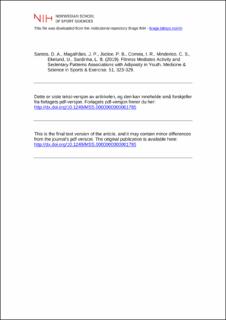| dc.contributor.author | Santos, Diana A | |
| dc.contributor.author | Magalhães, João P. | |
| dc.contributor.author | Júdice, Pedro B. | |
| dc.contributor.author | Correia, Ines R | |
| dc.contributor.author | Minderico, Cláudia S. | |
| dc.contributor.author | Ekelund, Ulf | |
| dc.contributor.author | Sardinha, Luis B | |
| dc.date.accessioned | 2020-03-19T14:35:06Z | |
| dc.date.available | 2020-03-19T14:35:06Z | |
| dc.date.created | 2019-05-14T18:24:26Z | |
| dc.date.issued | 2019 | |
| dc.identifier.citation | Medicine & Science in Sports & Exercise. 2019, 51(2), 323-329. | en_US |
| dc.identifier.issn | 0195-9131 | |
| dc.identifier.uri | https://hdl.handle.net/11250/2647629 | |
| dc.description | I Brage finner du siste tekst-versjon av artikkelen, og den kan inneholde ubetydelige forskjeller fra forlagets pdf-versjon. Forlagets pdf-versjon finner du på lww.com / In Brage you'll find the final text version of the article, and it may contain insignificant differences from the journal's pdf version. The definitive version is available at lww.com | en_US |
| dc.description.abstract | Purpose: We aimed to examine the cross-sectional associations of patterns of sedentary time (ST) and moderate-to-vigorous physical activity (MVPA) with total fat mass index (FMI) and abdominal FMI (FMIabd) in children, and additionally, to analyze if cardiorespiratory fitness (CRF) mediated these associations. Methods: Fat mass index and FMIabd were assessed with dual-energy X-ray absorptiometry in 333 participants (172 girls) age 9 to 11 yr. MVPA, ST, breaks in ST per sedentary hour (BST/ST) and the number of daily sedentary bouts with various lengths (1–4, 5–9, 10–14, and Q15 min) were assessed with accelerometry and CRF using a maximal cycle test. Hayes_ PROCESS macro for SPSS was used for mediation analysis. Results: The number of shorter sedentary bouts (1–4 min) was inversely associated with FMI (A = j0.108), whereas longer sedentary bouts (5–9 min, A = 0.169; 10–14 min, A = 0.193; Q15 min, A = 0.377) had a positive association, independent of MVPA (P G 0.05). A similar trend was found for FMIabd. Moderateto-vigorous physical activity was negatively related to FMI (A = j0.029) and to FMIabd (A = j0.003). There were no main associations for ST and BST/ST (P 9 0.05). Cardiorespiratory fitness was inversely related to total and abdominal adiposity, and a large portion (40.9– 65.7%) of the associations of MVPA and sedentary bouts with both FMI and FMIabd were mediated by CRF. Conclusions: Time in MVPA and accumulating ST in shorter sedentary bouts is inversely related to adiposity. However, these associations may be mediated by CRF. Emphasis should be given to programs that target increases in MVPA, which may influence CRF while reducing sedentary recreational behaviors. | en_US |
| dc.language.iso | eng | en_US |
| dc.subject | breaks in sedentary time | en_US |
| dc.subject | bouts of sedentary time | en_US |
| dc.subject | physical activity | en_US |
| dc.subject | cardiorespiratory fitness | en_US |
| dc.subject | total body fat | en_US |
| dc.subject | abdominal body fat | en_US |
| dc.title | Fitness Mediates Activity and Sedentary Patterns Associations with Adiposity in Youth | en_US |
| dc.type | Peer reviewed | en_US |
| dc.type | Journal article | en_US |
| dc.description.version | acceptedVersion | en_US |
| dc.source.pagenumber | 323-329 | en_US |
| dc.source.volume | 51 | en_US |
| dc.source.journal | Medicine & Science in Sports & Exercise | en_US |
| dc.source.issue | 2 | en_US |
| dc.identifier.doi | 10.1249/MSS.0000000000001785 | |
| dc.identifier.cristin | 1697900 | |
| dc.description.localcode | Seksjon for idrettsmedisinske fag / Department of Sports Medicine | en_US |
| cristin.ispublished | true | |
| cristin.fulltext | postprint | |
| cristin.qualitycode | 2 | |
